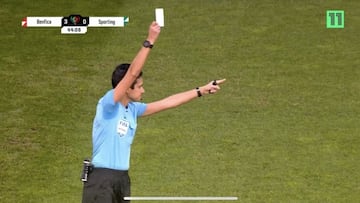First ever white card shown in soccer: what does it mean?
We’re used to yellow and red cards but now a new option is being trialled in Portugal with a very different meaning.

On Saturday, referee Catarina Branco entered the history books of the Beautiful Game by becoming the first referee to show a white card. That’s right, it wasn’t one of the yellow or red cards that we’re more than accustomed to and comes after the option was established in Portugal a few months ago. But what does it mean?
Los cuerpos médicos de Benfica y Sporting debieron auxiliar a un hincha en el derbi femenino por la Taça de Portugal 🇵🇹. Tras su rápido accionar, fueron reconocidos con una tarjeta blanca. ⬜️⚽️❤️👏pic.twitter.com/hrJu6L9XCy
— VarskySports (@VarskySports) January 21, 2023
What does the white card mean?
Branco’s historic moment came in the women’s cup match between Benfica and Sporting Lisbon, the Portuguese referee showed the peculiar card just before half-time. The new initiative aims to recognize the ‘fair play’ in the game.
Interestingly, on this occasion, the card was not shown to a player from either team, nor the coaching staff. Instead it was the medical team that were acknowledged after they quickly came to the aid of a person who had fainted. Those in the Estadio da Luz joined in by standing up and giving a warm ovation to the medics from both clubs.
Related stories
“Improving the ethical value in sport” is the purpose of this white card that represents a 360 degree change in the type of ‘cautions’ the referees can brandish. Ever since the 1970 World Cup until now, officials only had yellow and red cards, and these have been well used, as we know. This new initiative, though, looks to encourage players and others involved in the game to act in a more sporting manner. Portugal as a pioneer in this, and we will see if the future of major leagues around the world follow suit.
Sporting moments of the past for white card consideration
If white cards had existed before, here are some moments that would likely have merited the awarding of one:
- 1982 FIFA World Cup: the French captain Michel Platini allowed the goalkeeper of the opposing team, Harald Schumacher, to score a goal after Schumacher had been injured during the match.
- 2012 London Olympics: the U.S. Women’s soccer team gave their gold medals to the Japanese team as a symbol of solidarity after the devastating tsunami that hit Japan earlier that year.
- 2014 FIFA World Cup: Colombian player James Rodríguez consoled Uruguay’s goalkeeper Fernando Muslera after Muslera made a crucial mistake that contributed to Uruguay’s elimination from the tournament.
- 2016 Copa America Centenario: Argentine player Lionel Messi handed his match-worn jersey to a young Chilean fan who had been crying after Chile lost the final match to Argentina.
- 2000 English Premier League: West Ham’s Paolo Di Canio catches the ball when he had an open goal against Everton after spotting goalkeeper Paul Gerrard pulling up injured.

